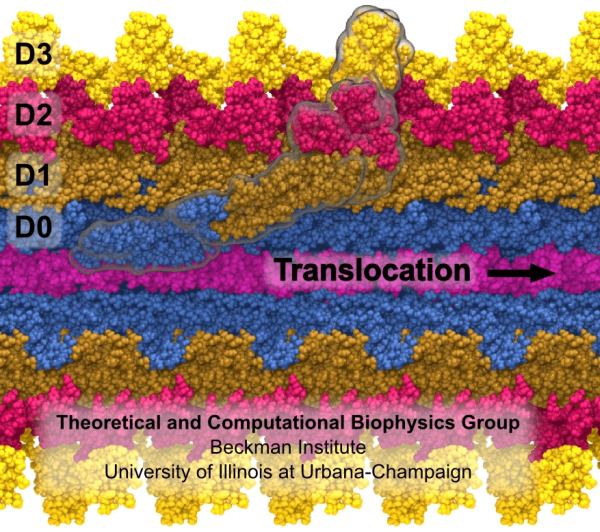NAMD is a parallel, object-oriented molecular dynamics code designed for high-performance simulation of large biomolecular systems.
NAMD is written using the Charm++ parallel programming model, noted for its parallel efficiency and often used to simulate large systems (millions of atoms). NAMD is implemented using the Converse runtime system.
Converse provides machine-independent interface to all popular parallel computers as well as workstation clusters.
Features include:
- VMD used to prepare molecular structure for simulation.
- Also reads X-PLOR, CHARMM, AMBER, and GROMACS input files.
- Psfgen tool generates structure and coordinate files for CHARMM force field.
- Efficient conjugate gradient minimization.
- Fixed atoms and harmonic restraints.
- Thermal equilibration via periodic rescaling, reinitialization, or Langevin dynamics.
- Force Field Compatibility.
- Efficient Full Electrostatics Algorithms.
- Multiple Time Stepping.
- Input and Output Compatibility.
- Dynamics Simulation Options – MD simulations using options such as:
- Constant energy dynamics.
- Constant temperature dynamics via:
- Velocity rescaling.
- Velocity reassignment.
- Langevin dynamics.
- Periodic boundary conditions.
- Constant pressure dynamics via:
- Berendsen pressure coupling.
- Nosé-Hoover Langevin piston.
- Energy minimization.
- Fixed atoms.
- Rigid waters.
- Rigid bonds to hydrogen.
- Harmonic restraints.
- Spherical or cylindrical boundary restraints.
- Interactive molecular dynamics simulations.
- Accelerated molecular dynamics provides a robust biasing potential that increases the escape rates from potential wells, while still converging to the correct canonical distribution.
- Load balancing.
- Shared-Memory Multicore and SMP Builds.
- Replica-based umbrella sampling via collective variables module.
- Optimized shared-memory single-node and multiple-node CUDA builds.
- CUDA GPU-accelerated generalized Born implicit solvent (GBIS) model.
- CUDA GPU-accelerated energy evaluation and minimization.
- Native CRAY XE/XK uGNI network layer implementation.
- Faster grid forces and lower-accuracy “lite” implementation.
- Hybrid MD with knowledge-based Go forces to drive folding.
- Linear combination of pairwise overlaps (LCPO) SASA for GBIS model.
- Weeks-Chandler-Anderson decomposition for alchemical FEP simulations.
- Native replica-exchange implementation for CRAY XE/XK and BlueGene/Q.
Website: www.ks.uiuc.edu/Research/namd
Support:
Developer: Theoretical and Computational Biophysics Group (TCB) and the Parallel Programming Laboratory (PPL)
License: Non-Exclusive, Non-Commercial Use License

NAMD is written in C++. Learn C++ with our recommended free books and free tutorials.
| Popular series | |
|---|---|
| The largest compilation of the best free and open source software in the universe. Each article is supplied with a legendary ratings chart helping you to make informed decisions. | |
| Hundreds of in-depth reviews offering our unbiased and expert opinion on software. We offer helpful and impartial information. | |
| The Big List of Active Linux Distros is a large compilation of actively developed Linux distributions. | |
| Replace proprietary software with open source alternatives: Google, Microsoft, Apple, Adobe, IBM, Autodesk, Oracle, Atlassian, Corel, Cisco, Intuit, and SAS. | |
| Awesome Free Linux Games Tools showcases a series of tools that making gaming on Linux a more pleasurable experience. This is a new series. | |
| Machine Learning explores practical applications of machine learning and deep learning from a Linux perspective. We've written reviews of more than 40 self-hosted apps. All are free and open source. | |
| New to Linux? Read our Linux for Starters series. We start right at the basics and teach you everything you need to know to get started with Linux. | |
| Alternatives to popular CLI tools showcases essential tools that are modern replacements for core Linux utilities. | |
| Essential Linux system tools focuses on small, indispensable utilities, useful for system administrators as well as regular users. | |
| Linux utilities to maximise your productivity. Small, indispensable tools, useful for anyone running a Linux machine. | |
| Surveys popular streaming services from a Linux perspective: Amazon Music Unlimited, Myuzi, Spotify, Deezer, Tidal. | |
| Saving Money with Linux looks at how you can reduce your energy bills running Linux. | |
| Home computers became commonplace in the 1980s. Emulate home computers including the Commodore 64, Amiga, Atari ST, ZX81, Amstrad CPC, and ZX Spectrum. | |
| Now and Then examines how promising open source software fared over the years. It can be a bumpy ride. | |
| Linux at Home looks at a range of home activities where Linux can play its part, making the most of our time at home, keeping active and engaged. | |
| Linux Candy reveals the lighter side of Linux. Have some fun and escape from the daily drudgery. | |
| Getting Started with Docker helps you master Docker, a set of platform as a service products that delivers software in packages called containers. | |
| Best Free Android Apps. We showcase free Android apps that are definitely worth downloading. There's a strict eligibility criteria for inclusion in this series. | |
| These best free books accelerate your learning of every programming language. Learn a new language today! | |
| These free tutorials offer the perfect tonic to our free programming books series. | |
| Linux Around The World showcases usergroups that are relevant to Linux enthusiasts. Great ways to meet up with fellow enthusiasts. | |
| Stars and Stripes is an occasional series looking at the impact of Linux in the USA. | |
